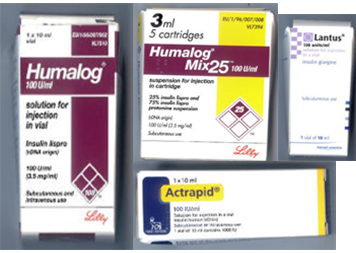Insulin
You will know that insulin is used for the treatment of type 1 and type 2 diabetes. However did you know that between November 2003 and November 2009, the NPSA (2011) received 16,600 reports of medication incidents involving insulin? Of these, 24% were reported as having caused patient harm.
Common causes of patient harm included:
- Inappropriate doses being prescribed or administered
- The wrong type of insulin being prescribed or administered
- Inappropriate abbreviation of the term “unit” leading to ten-times dose administration errors
- Delayed or omitted doses
Look at chapter on insulins in the BNF. You will see that there are over 20 different types of insulin available in the UK at present. They can be human insulin analogues or extracted from animals. They can be rapid acting, short acting, intermediate acting or long acting. They are available as a mixture of different insulins, known as biphasic insulins. They are also available in a number of different injection formats.
Can you see the potential for confusion when prescribing or administering insulin? Especially with insulins that have similar sounding names, such as Novorapid and Novomix, or insulins that have small differences in their name such as Humalog, Humalog mix 25 and Humalog mix 50.
Inappropriate dosing and wrong product selection with insulin can cause severe patient harm and patient death. This has been so well publicised by the NPSA, that the Department of Health (2012) has classed it as a ‘never event’.
Do you have the knowledge and training needed prescribe insulin safely? The BNF will provide you with essential prescribing information about each insulin. In addition MIMS online will give you information about administration and the duration of action of different insulins.
Patients should also be empowered to take an active role in their treatment with insulin. In support of this, the NPSA has developed a patient information booklet, along with a patient-held record, the insulin passport which will document the patient’s current insulin regime. This will also enable a safety check for you as the prescriber. These are available on the now decommissioned NPSA website www.nrls.npsa.nhs.uk
What are the key learning points for you as a future prescriber of insulin?
 Insulin
Insulin
Have a look at these different types of insulin. Do you know the difference between them?

Answer
What are the key learning points for you as a future prescriber of insulin?
To reduce prescribing errors with insulin, always write:
• INSULIN and TYPE (e.g. Insulin glargine)
• BRAND NAME (e.g. Lantus)
• The DEVICE to be used (e.g. Innolet)
• The DOSE clearly and the word “units” in full
What is the difference between the types of insulin?
Humalog is a rapid acting insulin analogue, usually given with or immediately after meals. Actrapid is a short acting insulin, usually given 15-30 minutes before meals and in diabetic emergencies. Humalog mix 25 is a biphasic insulin. This means it is a mix of a rapid acting and intermediated acting insulin. It is usually given twice a day. Lantus is a long acting insulin, usually given once a day.
Copyright eBook 2019, University of Leeds, Leeds Institute of Medical Education.